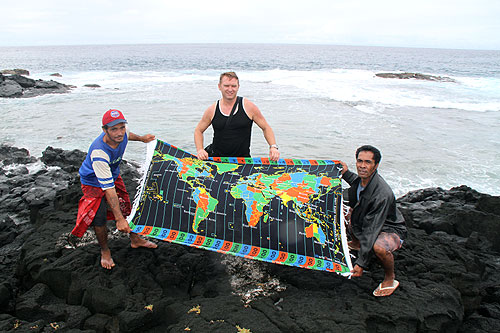09 May 2011, Samoa - "Samoa to switch time zones", Otago Daily Times
|
|
See Oceania Time Zone Map with current time
Cape Mulinuu (Sunset Point), X marks the western most tip of Samoa
and last spot in the world where you can watch the sun set each day (before December 2011). Savai'i, Samoa.
Photo © Alexander Krivenyshev, WorldTimeZone.com
|
 |
Samoa (Apia) will change timezone from UTC-11 to UTC+13 on December 29, 2011 so it would be west of the International Dateline, bringing its clocks similar to Tonga (UTC+13) and closer to New Zealand, Australia and Fiji and 24 hours away from American Samoa (Pago Pago).
International Dateline will move to the east from Samoa (Apia)- between Samoa and American Samoa (Pago Pago). (WorldTimeZone.com)
Samoa will jump back to the future in December when the Pacific nation switches time zones to make it easier to do business with New Zealand and Australia.
The country, which has long marketed itself as the last place on earth to see the sun each day, will skip forward a day to share the same day as New Zealand and Australia.
The mastermind behind the idea, Prime Minister Tuilaepa Sailele Malielegaoi, said the shift would make doing business in Australasia "far, far easier and more convenient".
"In doing business with New Zealand and Australia we're losing out on two working days a week," Tuilaepa said in a statement.
"While it's Friday here, it's Saturday in New Zealand and when we're at church on Sunday, they're already conducting business in Sydney and Brisbane."
Samoa and its neighbour American Samoa originally lay west of the international dateline until an American businessman convinced both nations to switch to the east in 1892.
"A local trader lobbied successfully for the change as it was convenient for trading ships from Europe and the United States that were servicing Samoa at the time," Mr Tuilaepa said.
"But our trading partners have dramatically changed since and today we do a lot more business with New Zealand and Australia, China and Pacific Rim countries such as Singapore."
He promoted the move as "great for tourism", but tourism operators don't agree.
A local tour guide, Andrew Tiatia, told the New Zealand Herald the country would lose a "great marketing point, and one which I take great pride in telling our visitors", referring to Samoa's sunsets.
"Once that's gone, we're just like the rest of the world."
He said sunsets at the country's southernmost point, where tourists flock, would be "no longer that special".
"After the date change, it will be just another sunset."
The shift will put a dateline between Samoa and American Samoa, an unincorporated US territory, a move that Mr Tuilaepa said would create "exciting tourism opportunities".
"You can have two birthdays, two weddings and two wedding anniversaries on the same date - on separate days - in less than an hour's flight across - without leaving the Samoan chain."
"We are looking forward to working with American Samoa on capitalising on the sort of tourism this change could garner."
But American Samoan residents are sceptical, saying the shift will make it impossible for the neighbours to do business efficiently.
Mr Tuilaepa, who is no stranger to controversial ideas, is unlikely to be deterred.
Under his leadership, Samoa switched to driving on the left in September 2009, a move that Australian road safety experts said was ill-conceived and lacked proper planning, consultation and justification.
More than 20,000 of the country's 178,000 residents protested the cost and inconvenience of the move but Mr Tuilaepa pushed on, telling his people "this is good for you. You will see."
Back to DST News
|
|
|